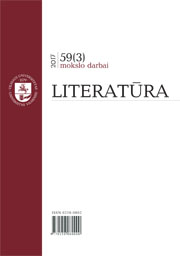ἦ μάλα θαῦμα κύων ὅδε κεῖτ᾽ ἐνὶ κόπρῳ: THE ANAGNORISIS OF ODYSSEUS AND HIS DOG ARGOS (HOM. OD. 17, 290–327)
ἦ μάλα θαῦμα κύων ὅδε κεῖτ᾽ ἐνὶ κόπρῳ: THE ANAGNORISIS OF ODYSSEUS AND HIS DOG ARGOS (HOM. OD. 17, 290–327)
Author(s): Magnus FrischSubject(s): Studies of Literature, Ancient World, Greek Literature, Ancient Philosphy
Published by: Vilniaus Universiteto Leidykla
Keywords: Greek epic; Homer; Odyssey; anagnorisis; animals in literature; dogs in literature;
Summary/Abstract: In the Odyssey, there is a description of Odysseus being recognized by his age-old and decrepit dog Argos, whom he had reared and trained himself before his departure for Troy. This so-called Argos episode (Od. 17.290–327) is still famous today. It has been continuously treated by generations of scholars from antiquity to our time and served as an inspiration to both the visual arts and literature. The present article deals with the function and intended effects of the Argos scene. After a brief synopsis of the position of this scene within the Odyssey as well as of its content and structure, the author discusses the role of dogs in the Iliad and the Odyssey. The focus of this article lies on the interpretations of the Argos scene, suggested by scholars so far, and on their review by means of a close reading to check their plausibility.
Journal: Literatūra
- Issue Year: 59/2017
- Issue No: 3
- Page Range: 7-18
- Page Count: 12
- Language: English

